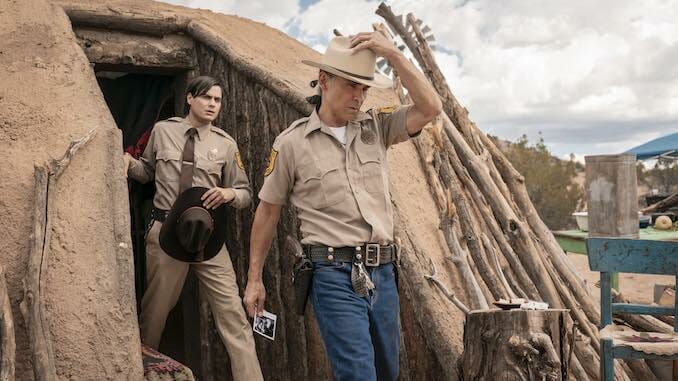AMC’s ’70s-Set Dark Winds Is an Engrossing Detective Story with a Hint of the Supernatural
Photo Courtesy of AMC TV Reviews Dark Winds
Navajo Nation, which occupies parts of Utah, New Mexico, and Arizona, is the largest Native American land holding in America, and is bigger in its own right than 10 states. And yet, how often is the region depicted on television and film in a way that doesn’t center white people, whether they’re fighting in a western, or driving through on Route 66 in a road movie? Graham Roland’s Dark Winds (which boasts an all-Native American writers room) doesn’t see the Navajo Nation as something to pass through, or something to conquer. In fact, it’s the outside world that gets just a brief visit, in the opening scene, when a gang with a helicopter pull off a well-executed theft of an armored car before disappearing into the Nation.
From then on, the bulk of the action in AMC’s six-episode series takes place within the working world of the Navajo police, led by Lt. Joe Leaphorn. Zach McClarnon, recently of Fargo and Westworld, takes on the role of Leaphorn, and plays him so well—with quiet dignity, a reluctant humor, and just enough menace to let you see what lies beneath the surface—that you quickly get the feeling nobody else would have worked. He’s a perfect bridge between the traditions of the Navajo Nation, which in this ‘70s milieu include witchcraft, and the outside world that infringes when something bad happens, but never seems to truly care. His sidekick is Jim Chee, played by Kiowa Gordon, who grew up within Navajo Nation, but is now an undercover FBI agent masquerading as a police officer whose job is to solve the helicopter heist.
The FBI is far more concerned with the stolen money than they are with a double murder at a hotel, mostly because the victims of that crime were both Navajo. Leaphorn susses out Chee’s true intentions early, and uses his FBI access to solve both puzzles. The murders are personal to him; his own son died in an explosion while working for an oil company three years earlier, and the girl who dies in the hotel was the boy’s girlfriend, and the daughter of Frank Nakai, with whom he has significant history. Nakai and his fellow villagers consider Leaphorn a kind of traitor, and view him with suspicion, while Chee and outsiders like FBI agent Whitover (Noah Emmerich, who always seems to turn up in these roles) scoff at what they consider the backward beliefs of the Navajo. In fact, Leaphorn is the only man who can help either of them.
The story is based on the popular Leaphorn and Chee book series written by Tony Hillerman, and there’s serious star power in the executive production roles, with both Robert Redford and George R.R. Martin on board. They’ve backed a winner here; from the gorgeous, stark southwestern setting to the mystery to the main characters to the hint of dark magic, everything works to heighten the drama and keep the action compelling despite a comfortable pace that matches the ‘70s aesthetic.
If there’s a complaint here, it’s that some of the acting doesn’t meet the extremely high standard Leaphorn and Gordon set, and while some of the side stories work effectively to paint the picture of this under-depicted culture, others seem shoehorned into the plot and aren’t nearly as interesting as everything else. In the grand scope, though, these are brief dips in quality that don’t detract much, if anything, from the show’s overall success. This is a case of writers, directors, and actors doing the important things very well, to the extent that slight deviations matter very little in the end.
I’ll admit that the presence of any supernatural elements in a detective show tends to give me pause, for the simple fact that they’re used too often as a crutch to support the narrative where logic and plotting fail; if you can’t write your way out of a tangled whodunnit, just use a demon. In this case, though, the darkness is subtle enough to contribute rather than subtract; it fits the atmosphere, and never becomes so egregious or important that it delegitimizes the actual crime story. In fact, it almost seems necessary in small doses; it’s easy to adopt the attitude of Chee, or any of the white outsiders in the story, in scoffing at notions of black magic, but because Leaphorn treats them with respect, and because it has a potent presence at least within this specific world, it hints at an undertow beyond our grasp. This is the kind of Indigenous flavor, they tell us, that was almost totally eradicated by the brutal expansion of European populations across the North American continent, and while it may not rate in Flagstaff or Gallup, much less Chicago or New York, it still holds sway in some places, and it still has power.
As the mystery deepens, Leaphorn is the prism through which we see the lingering effects of the conquest that is still resonant for the people who ended up on the wrong side of it. It is too easy for Americans with little experience among Indigenous populations to write off the story of westward expansion as settled history, when it is in fact a living history for the people like those in Navajo Nation. The influence is felt down the years, and just because a murder takes place in 1971 doesn’t mean it cannot trace its dark lineage back through the painful decades.
Dark Winds premieres Sunday, June 12th, with episodes released weekly on AMC and AMC+.
Shane Ryan is a writer and editor. You can find more of his writing and podcasting at Apocalypse Sports, and follow him on Twitter here .
For all the latest TV news, reviews, lists and features, follow @Paste_TV.